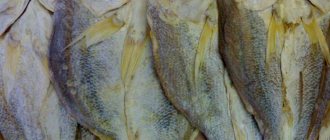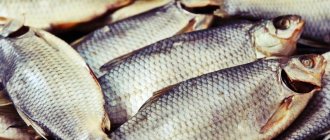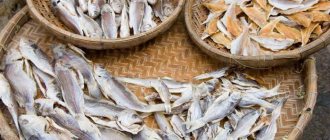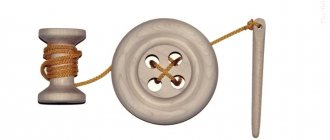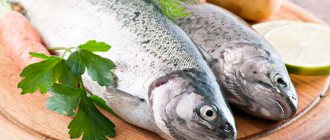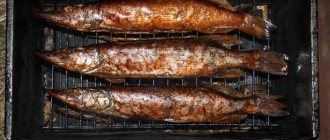Preparing fish for smoking
The preparatory stage involves the collection of raw materials.
A properly carried out preparatory stage is the key to successful hot smoking. It involves collecting raw materials, cleaning them, and salting them. The quality of the above activities affects the taste, aroma and benefits of the smoked product.
Fish selection
The key condition when choosing the best fish is strong scales, which will prevent the destruction of the top layer and the disintegration of the meat. The most suitable types for hot smoking:
- asp;
- perch;
- bream;
- zander;
- capelin;
- mackerel;
- cod.
Red fish is ideal for cooking in a smokehouse. From white, it is better to give preference to types with high fat content. By following the cooking technology, you will be able to create a delicious, unique delicacy from any fish.
For smoking, you should select carcasses of the same size, which will ensure uniform marinating and cooking.
Fresh fish is better. When using a frozen product, it is important to defrost it correctly. Individuals must be defrosted in natural conditions, without resorting to intensive methods.
Gutting
Having decided which fish is best smoked in a hot-smoked smokehouse, we proceed to cutting. This stage is important, because during high-temperature processing, uneviscerated specimens will acquire a bitter taste. When cutting, you should adhere to the following recommendations:
- Fish up to 400 gr. You don’t have to gut it, but it’s better to use carcasses without entrails.
- The head is cut off at will. If individuals are smoked with the head on, the gills should be removed.
- It's better to leave the scales. It will prevent soot from getting on the meat, as well as preserve juices and prevent the fish from falling apart during hot smoking.
- The black film inside the belly is cut off so that it does not add bitterness and spoil the taste of the product.
- Large carcasses are cut into fillets or longitudinal pieces of the same size.
When smoking whole carcasses, it is better to leave the tail, as with its help it will be possible to securely hang the product in the smokehouse.
Pickling
Fish for hot smoking is pre-salted.
This will transform the structure of the meat and fill it with the necessary taste. The dry salting option is considered simple and fast. 30-60 minutes before cooking, the carcasses are thoroughly rubbed inside and out with salt. The workpiece is placed in the refrigerator under pressure. This will allow the salt to penetrate deeper into the fibers and partially remove pathogens and excess moisture from the carcasses. For larger individuals, it will take 1.5-2 hours for complete salting. After salting, the fish must be soaked to remove excess salt. An alternative to dry salting is pickling in brine. It can be a mixture of water and salt or a solution with the addition of spices and spices. The classic recipe looks like this:
- 1 l. water;
- 2 tbsp. salt;
- 1 tsp Sahara;
- 3-5 pcs. bay leaf;
- 1 tsp ground black pepper;
- sage, thyme or other spices are added to taste.
The marinade is boiled and cooled, after which the fish is placed in it and left in the refrigerator for a day. It is better to use marinade to obtain original taste. To obtain a pronounced taste of fish, dry salting is suitable.
Drying
It is necessary to smoke dried fish using the hot method. In this regard, the workpiece is dried after marinating. Over-moistened carcasses run the risk of boiling in the smokehouse rather than being smoked.
For drying, 1-2 hours in the fresh air is enough.
The procedure removes excess moisture and makes the taste richer. In the summer, it is better to wrap the carcasses in gauze soaked in vinegar, which will repel insects. After drying, the fish is rubbed with sunflower oil.
Purchase and processing of fish
When purchasing, they are guided by the criteria of freshness and fat content of the fish. A fresh carcass is recognized by the following indicators:
- The eyes are transparent.
- The surface is complete.
- The meat is dense.
- The gills are pink or red.
- No yellowness.
It is best to purchase fresh carcasses.
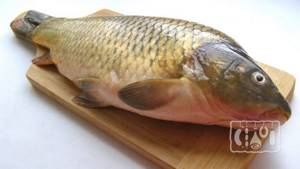
Fresh fish carcass
If the fish is frozen, the main thing is to defrost it correctly. This is done by placing it in cold water. Next, they gut it. Small specimens do not need to be gutted. All that remains is to salt it.
For salting, use the dry method or brine. To properly smoke fish, when dry salting, it is enough to completely rub the carcass with a curing mixture consisting of salt and seasonings, and keep it in this state for two hours. If salted in brine, the process takes twice as long.
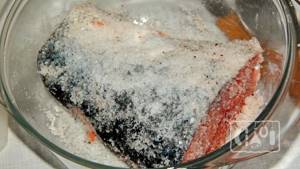
Salting fish using the dry method
Smoking process
Smoking is carried out in a smokehouse. If there is perfect sealing, it is possible to prepare the delicacy in apartment conditions. First of all, you need to prepare the smokehouse. It must be clean and dry. Next you need to perform the following manipulations:
- Pour wood chips into the bottom of the smokehouse. You should not use a lot of fuel, as this will cause bitterness. For one load, 2-3 tbsp is enough. wood chips
- A tray is installed to collect fat, since during hot smoking the flowing liquid has a negative effect on the smoldering of wood chips, and as a result, the taste of the fish deteriorates.
- The pickled and dried workpiece is loaded. The carcasses are placed on a grid or hung on hooks.
- Close the smokehouse lid and place it on the heater.
- As soon as the wood chips begin to smolder, the fire is reduced to maintain the process.
- When a lot of smoke is generated, the lid is opened slightly to release excess.
- At the end of cooking, remove the smokehouse from the heater and wait for the unit and the product in it to cool.
The total duration of hot smoking is 30 minutes - 2 hours, depending on the cooking conditions and the size of the fish. Before serving, you can add original notes to the dish by placing lemon slices inside the belly or sprinkling the product with cognac.
Types of fish for smoking
Choosing the right fish to smoke depends on your preferred cooking method. For hot smoking you need denser scales. For cold dishes, it is important to salt or marinate the preparations well.
The best red fish for smoking
Red fish is perfect for smoking in a smokehouse. This is especially true for chum salmon, whitefish, and pink salmon. When choosing sea fish, you need to pay attention to some features:
- shade of gills - they can be red or yellowish;
- belly color - only pink is allowed;
- the condition of the fins and tail - they are used to check whether the carcass has been frozen several times;
- smoothness of scales.
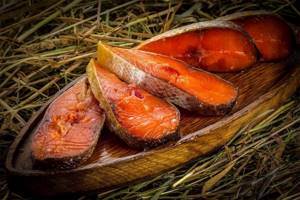
Red fish for smoking
Use fresh fish, without any unpleasant odor.
Your question to an expert
Leonid Grachev
Fisherman with a lot of knowledge and experience
Ask a Question
Composition and properties of smoked fish
Smoking allows you to preserve the maximum amount of vitamins and minerals in fish.
Eating smoked meats will help compensate for the lack of vitamins A, B, C, D, E, which are necessary to normalize digestion, improve vision, and stimulate metabolism. The presence of hot smoked fish in the diet improves your appearance and has a positive effect on the condition of your skin, nails and hair. The absence of carbohydrates in the composition promotes rapid absorption of the product. The proteins contained in the product are necessary for the body, and the fats are healthy and can prevent the formation of cholesterol plaques.
Cold smoked fish
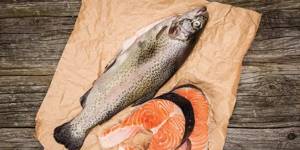
Cold smoking does not involve heat treatment. Instead, the fish are exposed to smoke for an extended period - at least several days - at a room temperature of about 30 degrees. This process is similar to classic drying, but gives a different, richer and more characteristic taste.
Before cold smoking, the fish must be salted. This allows you to extend the shelf life. And the salt itself serves as a preservative and prevents ready-made carcasses or fillets from spoiling. After smoking, additional processing is also required - drying or drying. The specific duration of these culinary processes depends on the variety.
Thus, cold smoked fish takes a very long time to cook. At best - only 2-2.5 weeks, at worst - more than a month. But this investment of time is worth it. Cold smoked fish is not only tasty - it can also be stored for a very long time, up to several months, subject to proper temperature and humidity conditions.
When salted and dried, the texture of the fish changes. It becomes denser and more elastic. The pulp is poorly separated from the skin and bones, so cold smoking is not suitable for small varieties of fish like capelin - “disassembling” the dish during consumption will be at least difficult.
But with low-temperature drying in a smokehouse you can make excellent balyks. Their firm, elastic flesh makes them suitable for sandwiches, holiday slicing, or simply included in other dishes such as salads or pies. They also keep for a very long time.
Also, the absence of exposure to high temperatures during smoking allows you to preserve beneficial substances in the dish. Fat is not rendered, vitamins are not destroyed. This fish is especially useful in the cold season, when the body experiences an acute shortage of various nutrients.
At the same time, salting and drying do not help get rid of parasite eggs. As a result, cold smoked river fish cannot be consumed without heat treatment! This also applies to silver carp balyks.
The taste of fish prepared in this way is quite unique. “Smoky notes”, of course, remain, but they do not dominate the main “bouquet”. Rather, the smoked taste complements the natural aroma. In some species, such as trout, pink salmon or sea bass, it is practically not felt at all.
In general, cold smoked fish is characterized as follows:
- Elastic, dense texture. The pulp is difficult to separate from the bones or skin, but is easily cut into neat thin strips or straws;
- Characteristic taste, which is complemented by “smoky notes”. There are smoked aromas, but they are not dominant. Cold smoking is ideal for fatty species that cannot boast of a strong flavor of their own, such as salmon or sea bass;
- Light color. When low-temperature drying in smoke, the fish acquires a desaturated golden or brown hue. The amount of resins in comparison with the hot version also decreases slightly, especially in the thickness of the pulp;
- Fatty acids are retained because fish oil is not rendered. But vitamins can be destroyed - although in the thickness of the pulp, where neither smoke nor air enters, they “remain intact”;
- Cold smoking does not involve heating to disinfecting temperatures, so it is not suitable for river or other freshwater species. They may contain bacteria or, more dangerously, parasite eggs.
Cold smoking is perfect for fatty fish. The best species to “open up” are salmon, ocean perch, mackerel and similar varieties. The absence of heat treatment and dense texture allows you to preserve and prevent fat from melting. But it is recommended to smoke already cleaned fillets in this way, since after all the procedures the meat will “stick” to the bones and skin.
So, let's summarize.
Advantages
- Preserves vitamins and fish oil, making the product more useful;
- Increases the shelf life of the finished dish - up to several months, subject to proper temperature and humidity;
- It has an extremely slight effect on the taste and aroma, allowing you to keep them natural;
- The finished dish contains fewer volatile resins, which are dangerous for people with sensitive digestion or its functional disorders.
Flaws
- Cooking takes a lot of time. That is why fish prepared in this way may have an increased price;
- The lack of heat treatment does not kill parasites, their eggs and harmful bacteria;
- Some people may like the elastic texture of the finished product, but others may not. Therefore, this is a very subjective criterion.
Calorie content
With a high content of useful micro- and macroelements, the smoked product has a low calorie content and can be included in the diet.
Depending on the type of raw material used, the calorie content differs.
The average figure is 166 Kcal. There are certain varieties that are high in calories, for example, 100 grams. mackerel – 317 Kcal. The lowest-calorie fish include pollock, blue whiting, and flounder. Hot smoked cod has the fewest calories – 75 Kcal per 100 grams.
Beneficial properties and harm
The main difference between white varieties and red ones is the reduced amount of fat. All red species, except perhaps pink salmon, are usually fattier than white salmon and contain more polyunsaturated fatty acids. However, this does not negate the fact that white meat also contains them.
Important! The white product contains a lot of phosphorus, magnesium, potassium, manganese, zinc, and vitamins of all existing groups.
Sea water, unlike river water, has much more iodine and vitamins B and D. It contains useful salts. River inhabitants are more nutritious and rich in iron, which they contain more than sea fish.
This makes the white delicacy a useful source of microelements, proteins and polyunsaturated fatty acids. But there are also dangers:
- large, old marine fish can accumulate mercury and heavy metals;
- insufficient salting makes fish hazardous to health due to bacteria and parasites, so before smoking you need to salt the product as best as possible;
- an abundance of salt can be dangerous for diseases of the heart, kidneys, gastrointestinal tract and liver.
The most dangerous sea creatures are tuna, summer flounder, grouper and bluefish. However, they are rarely found in stores.
Storage conditions
The hot smoked product is not subject to long-term storage.
A delicacy placed on the table will spoil within 10-12 hours, so it is necessary to serve only the amount that you plan to eat. After cooling, the rest of the product should be wrapped in foil or parchment and placed in the refrigerator. At a temperature of +2-+6°С, smoked meat will be preserved for 2 days, at -2-+2°С – for 3 days. In some cases, the product is frozen. In this form, it will retain its qualities for about 1 month, but defrosting should be done in stages so as not to damage the appearance. Homemade hot smoked fish will be a better option than a store-bought product, since its taste can be adjusted to personal preferences. By choosing the right variety, cleaning and marinating the product, you will be able to get the best result, please yourself and surprise your guests.
Useful tips
- Fresh fish is ideal for smoking; however, unfortunately, it is not always possible to purchase freshly caught fish. Then all that remains is to use frozen. It is best to defrost the fish naturally, namely, on the top shelf of the refrigerator, and then completely take the fish out and put it on the table. Do not use microwave ovens or other methods of temperature exposure for defrosting, as they take away most of the taste of the fish.
- Before starting the hot smoking process, it is important to choose the “right” wood, namely, the most suitable sawdust and wood chips. The best of their kind for smoking are fruit trees, as well as alder, oak, ash, maple, etc. Coniferous species cannot be used, with the exception of the juniper mentioned above.
- How to store hot smoked fish? As a rule, the most common method of storing fish involves storing it in the refrigerator. True, the fish must first be placed in paper or wrapped in cling film, since free access to oxygen will make the fish windy, and the fishy smell will transfer to other products. If you need an even longer shelf life for hot smoked fish, you can put it in the freezer, but then you need to be prepared for the fact that the fish will subsequently lose half of its taste.
These simple tips will help even a beginner cope with hot smoking, and if you try, the result will exceed all your wildest expectations!
Here is a good video on how to smoke fish while fishing in a cauldron:
Types suitable for smoking
Smoking fish has long been known in fishing villages and bases located on the seashore. Currently, fish smoking is carried out using high-performance installations. Industrial fish smoking is concentrated on the coast. Currently, more than 40 species of marine fish are eaten, many of which are sold smoked.Special delicacies produced in smokehouses on the coast include smoked herring, sprats and eels.
If we take into account the large volume of imports, then until now, herring (Fig. 1) occupied first place among the harvested marine fish species. The herring carcass is smoked whole, that is, with the head and entrails.
Rice. 1. Herring (Clupea harengus)
Smoked Shlai herring is a tender, lightly salted Baltic herring that is caught in the lower reaches of the Shlai River at its confluence with the Baltic Sea. As for the delicious hot-smoked herring, which has a more delicate taste, it is prepared from gutted herring, separating the head before processing.
Sprat received the same distribution. It is not gutted before smoking. This is a type of fish similar to herring, but very small in size. Often sprats end up in the same net with small herring, however, given their high taste, they are selected for further processing. A special delicacy is Kiel sprats, mined in Kiel Bay, where they are processed. Sprat fishing begins in November and ends in March.
Small herring, which is smoked in the same way as sprat, but rated lower in quality, is called sprat herring.
Herring differs from sprat in size and arrangement of fins. The base of the pelvic fins of the herring is located behind the dorsal fin, while that of the sprat is in front of it.
By these characteristics, real sprat can be distinguished from small herring. Herring and sprats are smoked whole. Sometimes the herring is cut into two halves along the back line before smoking with low-temperature smoke. High-temperature smoke is used to smoke the whole carcass.
Recently, in Germany, the catch of cod and sea bass has quantitatively exceeded the actual catch of herring. The average weight of Atlantic cod reaches 10-20 kg, North Sea cod weighs 5-7 kg, so they are not smoked whole, but in pieces. Often, Baltic cod also refers to juvenile cod. Cod (Fig. 2) is a typical skinny fish. Fats and vitamins accumulate in the liver. Cod is easily recognized by its white lateral line. Baltic cod is smaller in size, and therefore in some cases it can be smoked whole. The same applies to related species of cod, such as haddock and whiting, if their mass does not exceed 400 g. All types of cod are characterized by the presence of three rather large dorsal fins located close to each other. The pelvic fins form a groove in front of the pectoral fins. Growing haddock with a black lateral line has not very dry and soft meat. Among cod fish, pollock is also highly valued, but, of course, not as much as salmon.
Rice. 2. Cod (Gadus morhua)
Large carcasses of all cod fish are smoked in pieces. Other types of large sea fish, such as catfish and tuna, are also smoked cut into pieces.
The sea fish market currently supplies about the same amount of sea bass as cod. Sea bass is a fatty, vitamin-rich fish. It is caught in the Atlantic, off the Lofoten Islands, off the coast of Iceland and the coast of Murmansk. Smoked pieces of sea bass, as well as fillets of this fish, are in very high demand.
Smoked parts of some types of fish, the names of which might cause antipathy among the buyer, have rather euphonious trade names. In this case, the goal is to avoid negative emotions, which, perhaps, only a man-eating shark deserves. For example, the name “common conger eel” refers to pieces from the back of a spiny shark; “Schiller curls” - pieces from the belly of a hot-smoked spiny shark; “calf fish” - pieces of herring and dog shark, “spike fish” - cartilaginous pieces of dog shark.
The numerous mackerel family lives in warmer waters. Only two species are found off the European coast. One of them is the common mackerel (Fig. 3), which lives in the North Sea. This fish lives in migrating schools, and from summer to autumn in coastal waters. It is easily recognized by its shape, fin outline and color. Thanks to its narrow caudal peduncle with a high caudal fin, mackerel appears to be a slender fish. The second dorsal and anal fins end in five small accessory fins. There is a hard, sharp spine between the anus and the anal fin. At the market, this fish attracts attention with a stripe-like dark blue pattern on the back, the lines of which run vertically across a silvery-white background. However, this pattern does not match the natural coloration of the fish. In the water and immediately after catch, the back of the mackerel is bright green with three slightly dark stripes. The mackerel's belly is pearlescent. The maximum length of this fish species is 50 cm, weight 1.5 kg. Mackerel feeds on zooplankton and, after the spawning period, on small fish. Often during a fast chase it moves almost on the surface of the water. It is not surprising that such a fish attracts sports fishermen, especially since, despite its modest size, it fights desperately when hooked. Fish meat is fatty and when smoked is a special kind of delicacy.
Rice. 3. Mackerel (Scomber scombrus)
Mackerel can be found in summer in the western regions of the Baltic, as well as in schools between the North and Baltic seas, depending on the current, which changes its direction under the influence of the wind. In these areas, mackerel is also caught with great pleasure by sports fishermen during collective trips. Mackerel spawn from May to June at various points in the North Sea, in the Skagerrak and Kattegat straits close to the surface of the water. Usually, starting from September, mackerel leaves coastal waters and lives in the North Sea in winter at great depths near the bottom.
Another type of mackerel is the Mediterranean type. It differs from the North Sea mackerel in the presence of a swim bladder, smaller size and fewer dorsal fin rays.
Mackerel is an important commercial fish. Professional fishermen catch it with drift nets, purse seines and trawls. To smoke it, it is cut from the back and the insides are removed without cutting the belly.
Flat-shaped fish, so called because their body is strongly compressed laterally, are in high demand on the coast and in fishing ports. They are becoming increasingly popular in inland areas because they have a pleasant taste and are boneless apart from a backbone, a small number of ribs and a two-row base of the fin ray. Many types of flat-shaped fish are smoked whole or in pieces depending on their size. Smoked flounder is a high quality product. Smoked pieces of halibut, the largest flat-shaped fish, are also highly valued for their special taste.
Halibut is found from the coast of Greenland to the Bay of Biscay. Its length reaches 2 m or more, and its lifespan is about 40 years. Halibut feeds on fish, as well as fairly large bottom-dwelling animals. Due to the large size of the halibut, it has to be cut into pieces and then smoked. In addition, halibut has been and remains an important commercial fish. Unfortunately, in halibut feeding areas in the Baltic Sea, if the fish were at shallow depths, they were caught intensified. Halibut spawn in winter (December to April). Its meat becomes especially tasty in the last months of the calendar year.
River flounder (Fig. 4) is in most cases eaten smoked. This typically eastern Atlantic fish, which lives in the waters from the White to the Black Sea, is not so strongly affected by the salt content of the water. It can migrate from the Baltic Sea to sea water mixed with fresh water, and then to the mouth of a river with completely fresh water. The river flounder is a close relative of the sea flounder, which has a similar distribution area, i.e. from the Barents Sea and Iceland to the Bay of Biscay. The preferred habitat is the North Sea, but it is also found in Baltic waters, with the exception of bays. The consumer evaluates these two types of flounder differently. Sea flounder is said to have tender, soft meat, while river flounder meat is coarse and tough. It is in the interests of the consumer to be able to distinguish between these two types, especially since both sea and river flounder are sold as whole smoked carcasses. The river flounder has rough scales, small spines along the dorsal and anal fins form a dense row. The flounder has smooth, small scales, and only between the eyes and on the head does it have a short row of small bony plaques. At first glance, you can easily determine whether a fish has rough or smooth scales, and even more so if you run your finger over it. The sea flounder has pronounced red, dot-shaped growths on the upper side, as well as on the fins. There are fewer of them on the scales of river flounder, they are quite blurred, and on the fins there are none at all.
Rice. 4. River flounder (Platichthys flesus)
The third species of flounder is the limanda, which lives in the same regions as the two named species. Noteworthy are the outlines of its lateral line, which describes an arc above the pectoral fin closest to it. Limanda is somewhat cheaper than sea and river flounder.
Turbot is also sometimes smoked.
In terms of taste, fish from the sole family are rated highest; many even consider them the most delicious among all marine fish. Smoked sole fillet is, of course, a delicacy.
Distinctive features of the sole are a slightly elongated, non-pointed head and a dorsal fin that reaches eye level.
As is known, salmon is recognized as a first-class valuable commercial fish (Fig. 5). Smoked salmon cut lengthwise is a delicacy of the highest quality.
Rice. 5. Salmon (Salmo salar)
Salmon develop quickly in salt water, go to fresh water to spawn, and rise to the upper reaches of rivers and streams, without food. Currently, measures to regulate river flow, as well as dams and wastewater, have sharply worsened the breeding conditions for salmon. In Germany it practically no longer occurs.
Brown trout have a similar life cycle. This species lives in salty sea water. For sport fishermen, salmon and brown trout are valuable trophies, and the long journey to the rivers where these species live is not an obstacle. In the territorial waters of Germany (North and Baltic seas) small populations of brown trout still exist.
Salmon, unlike brown trout, has a more slender body, a narrow caudal peduncle, and a caudal fin with a small notch at the end. The tail fin of the brown trout is, as it were, vertically cut, i.e., it ends straight. The maxillary bone of salmon reaches the posterior edge of the eye; in brown trout, it extends beyond the posterior edge of the eye. There are only a few black X-shaped dots on the sides of the salmon. Brown trout have many of them, including under the lateral line, on the caudal and dorsal fins. Both species, like all members of the salmon family, have a small adipose fin behind the dorsal fin. Male salmon dress in colorful mating plumage during the spawning season. The back becomes steel blue, the sides are reddish with clearly visible blue spots, the ventral side is painted black and red.
The summary of fish species presented here provides an overview of the most common marine fish processed by the fishing industry and used for smoking both commercially and for recreational purposes. So, we can assume that the reader has received an approximate idea of seafood.
The main goal of our book is to help, first of all, fishermen fishing in inland waters and at sea to learn how to smoke fish themselves, so only small smoking devices and chambers will be considered here.
What species living in inland waters are suitable for smoking? First of all, we should name the eel.
The European eel (Fig. 6) is a freshwater fish. During its long migration to its spawning grounds in the Sargasso Sea in the western North Atlantic south of Bermuda, it expends enormous energy. Throughout this long journey, the eel goes without food, and at the same time its gonads are formed, so it would be impossible for it to overcome this path without having solid reserves of fat.
The eel spends most of its life in fresh water. During this period, its life cycle has a number of features that should be taken into account during the smoking process.
Rice. 6. European eel (Anguilla anguilla)
According to Ehrenbaum, female eels develop faster in fresh water from the fourth year of life than males. Typically, the three years of larval development spent at sea are not taken into account. At subsequent stages of development, females have greater mass.
Acne at the same stages develops differently. Feeding experiments carried out in warm water have shown that differences in growth are greater than in any other fish species. When catching eels in natural reservoirs, the same picture can be observed. There is a big difference between eels of the same age in size and weight.
In fresh water, the eel changes color. Most of the time, its back is greenish to brownish in color. The eel's belly is bright yellow. These are, in fact, the years of active feeding during which the eel develops. The freshwater period of life is the fattening and growth phase. At this stage, the eel is called maturing. Its color changes as soon as the initial period of puberty occurs. The back darkens, a metallic sheen appears; the abdomen becomes silvery-white. Now it is called light eel, and in some areas - silver eel. With the change in color, the eel begins to migrate downstream of the river to the sea. Its meat becomes coarser than that of the common eel, and its skin is thicker. These age-related changes, especially the thickness of the skin, should be taken into account when smoking.
During the development of the eel in fresh water, further differences appear. There are eels with both sharp and broad heads. The reason for this polymorphism is the different way of feeding. The broad-headed eel is more of a carnivore than the pointed-headed eel, which prefers small animals. According to Wiehr, the eel with a pointed head has a fat content of 27% of its live weight (average), i.e. higher than the broad-headed eel (12% fat). Thus, it is more advisable to use eels with a pointed head for smoking.
According to Meyer-Waarden, female eels are fatter than males. In addition, the percentage of fat in individual parts of the body varies. For example, in the tail section the fat content is higher (37.2%) than in the middle section (25.9%). However, if we take smaller males for comparison, the difference will be much smaller.
Differences in fat content, meat texture and skin thickness require individual smoking methods. Since eels of the same length may vary in these characteristics, the duration of smoking will need to vary.
It should also be taken into account that the composition of eel populations in rivers and lakes changes depending on the time of year. Of the eels that penetrated or were transported to rivers remote from the coast, the individuals that went farthest to the upper reaches of the rivers returned to the sea earlier, rather than those living in reservoirs close to the coast. Small male eels begin migration first, sometimes as early as May, when the color change has not yet begun before moving to the light eel stage. In females, migration occurs later, and by this time they are already at the light eel stage. Thus, the composition of the eel population undergoes some changes from May to the autumn months.
This is especially noticeable in waters where migrating light eels are already found in large numbers, i.e. in the lower reaches of rivers and in the Baltic Sea, through which the light eel enters the Atlantic Ocean in the fall from the rivers and lakes of the Baltic states, which have long been considered the main fishing area . First, small eels appear here, later - the largest ones.
Eel catches from inland waters have never allowed the full capacity of smoking plants in coastal areas to be used. Demand for eel in Germany is stable. Sales are carried out without any difficulties. Most eels are smoked.
Before the Second World War, Germany ranked third in northern Europe in eel farming. Currently, the annual turnover of eel farming enterprises is at least 50 million West German marks. Germany currently ranks eighth in the world among eel fishing countries. The area around the island of Rügen and the coastal waters of Pomerania alone accounted for about 75% of the total pre-war catch of Baltic eels.
Currently, demand mainly has to be met through imports, and the profession of eel smoker remains prestigious to this day.
Increasing the productivity of fish farming in the inland waters of Germany by creating new enterprises for fattening eels when grown in warm waters is extremely necessary, otherwise a reduction in the trade in smoked eels is inevitable. Eel is becoming increasingly popular among people living in areas remote from the sea. This is explained by the fact that eel is generally recognized as a gourmet fish. There has long been no prejudice about the fact that eels feed on carrion. Feeding experiments have proven that eels are picky in eating food.
In addition, the consumer has learned to distinguish tasty smoked river eels from very similar sea eels, also sold smoked.
form, but representing a completely different type of fish with dry, coarse meat, much inferior in taste to river eel. The sea eel differs from the river eel in having a longer dorsal fin, reaching almost to the head.
When smoking a large number of eels, you should, if possible, select and place fish of the same weight and size in the smoking oven. However, it is precisely in this regard that difficulties often arise.
As for other types of freshwater fish, older readers will probably still be able to remember the first primitive smokehouses of professional fishermen. In resort areas and in fishing villages on rivers and lakes, they smoked freshly caught fish in wooden tubs and barrels. For the same purposes, the simplest small stoves made of brick were also used. Customers waited patiently for the still warm goods to be delivered straight from the chimney. Today, almost every fishing enterprise has a modern factory-made smoking chamber, and the smoker himself sells smoked fish. On the lakes of Bavaria and Holstein, most of the whitefish catch (Fig. 7) goes to smoking plants. Characteristic features of such valuable fish as salmon, trout, and char are an additional soft adipose dorsal fin, as well as the absence of intermuscular bones, which make them difficult to eat.
Rice. 7. Whitefish (Coregonus - Arten)
As for rainbow trout (Fig. 8), bred at trout stations, it appeared in Western Germany only in the post-war years. In the pre-war years, trout was considered a delicacy fish, which was served only on special occasions. However, recently trout can be seen on any menu. As a portioned fish ready for culinary processing, it is constantly on sale live or frozen. With an increase in living standards, this fish, including smoked fish*, is in increasing demand among all segments of the population.
Rice. 8. Rainbow trout (Salmo gairdneri)
Germany's own production is no longer able to satisfy market needs, so rainbow trout is currently imported live or frozen from various countries, primarily from Denmark and Italy. Trout breeding stations in Germany are forced to use imported supplies to meet consumer demand and uninterrupted supplies of smoked trout to the buyer.
Among the population of Germany, along with trout, carp is widely known among other valuable freshwater fish (Fig. 9). It is released into our natural reservoirs, lakes and slow-moving rivers as a biennial planting material. Since it is not easy to catch carp, in natural reservoirs it lives longer and reaches larger sizes than in ponds where water is drained to remove the entire stock of fish. Large, shallow ponds with almost no current always provide ideal conditions for carp. In the fall, when the water becomes cold and fish growth stops, these ponds give up their entire supply of carp. The average weight of three-year-old carp by this time is 1.5 kg. These are the feeding carps that go on sale around Christmas in the north of Germany and in the countries east of West Germany. In the pre-war years in southern Germany, carps were eaten only on Good Friday.
Rice. 9. Carp (Cyprinus cartpo)
Currently, in the south of Germany, carp can only be seen on the table during the Christmas holiday. However, for now, consumers prefer to buy live carp. Nevertheless, the substantial annual production of feeding carp in Germany, equal to approximately 40,000 tons, is far from being able to meet demand. Therefore, large quantities of carp are imported at the end of each year from other countries (GDR, Poland, Czechoslovakia, Hungary, and Yugoslavia).
However, those who have recognized the delicate taste of smoked freshwater fish know the value of carp. These are primarily sports fishermen, among whom independent smoking of carp caught with a fishing rod in the warm season is becoming increasingly common. Large fish are cut lengthwise or cut crosswise into pieces. Those who like a spicy taste can lightly rub a clove of garlic on the inside of the fish. As you can often hear from fishermen, they like their own smoked fish so much that they will never give up this type of processing. We often hear that carp meat is too soft in the warm season. However, during the smoking process, carp meat undergoes certain changes and acquires the desired density.
The same applies to other freshwater fish, in particular the many species of cyprinids, by which we mean species similar to carp.
In this regard, special mention should be made of the tench (Fig. 10). It, like carp, is considered a valuable fish, and many people prefer it. Tench live in the same ponds as carp and are brought to market alive. Tench can be smoked whole. Connoisseurs appreciate smoked tench, which has excellent taste after any culinary treatment. In lakes and rivers, tench have enough time for prolonged growth. Sometimes quite large specimens are found, but they do not reach the same weight as old carp.
Rice. 10. Tench (Tinca tinca)
Bream (Fig. 11) is also widely known. In the pre-war years, large quantities of bream were caught in the eastern and northern regions of Germany in winter using the ice fishing method, which is no longer so popular. In Bavaria, professional fishermen fishing on the Chiemsee can say that they were the first to begin mass smoking of bream in the summer. But we will talk about this later. Full-aged, large bream weighing about 2 kg can be quite fatty and, according to experienced tasters of fish dishes, its taste is not inferior to carp, especially since its meat is quite dense. In coastal areas where smoked bream is traded, there are absolutely no difficulties in selling this fish. Against! Fishermen would be happy to increase bream fishing to meet demand.
Rice. 11. Bream (Abramis brama)
The successful sale of this type of fish should, in fact, serve as a signal to begin smoking other species of the carp family in order to effectively counteract the difficulties with the sale of these types of fish. In this regard, amateur fishermen already have a wealth of experience. A good sports fisherman is not only a lover of nature, but in most cases also a skilled craftsman. This is due to the testing of everything new and, not least, the smoking of other types of fish. Anglers have already successfully smoked various species of the carp family. Judging by their experience, cheese, although outwardly not similar to bream, but systematically belonging to the carp family, is quite suitable for smoking. It lives in the lower reaches of rivers in the north of Germany, in the bays of the Baltic Sea, as well as in the southern regions, in particular on the Danube. In addition, roach (Fig. 12), orfa, asp, which is a rather large predatory species of the carp family, are suitable for smoking. There is another typical type of freshwater fish - large river barbel, which is suitable for smoking, as are small species of fish - dace and sea bleak. Herbivorous fish that have recently acclimatized in pond farms are also quite suitable for smoking. This list could be continued. Just as among sports fishermen there are specialists in certain types of fish, there are also among smokers. Sometimes a fisherman who uses flies as bait even smokes the grayling he catches; many pike lovers smoke their catch, and some anglers use pike perch or perch caught on a hook for smoking. Smoked catfish is a special delicacy.
Rice. 12. Roach (Rutilus rutilus)
If you ask an amateur fisherman what types of fish are suitable for smoking, he will name so many that one gets the impression that it is possible to smoke not only fish that were previously eaten only fresh, but also some species that are still considered not quite edible. Although there is no dispute about tastes, when talking about smoking, it should be borne in mind that the aroma of smoke smoke in some way conceals the differences in the taste of individual types.
When smoking fish, you can forget about taste differences due to the season, the formation of eggs, the end of spawning, or the temperature influences of individual months, since under any circumstances the smoky flavor will prevail.
It should also be noted that frying fish on a grill, as well as cooking fish by heating without adding fat and often using smoke, has become widespread. In the sections of fishing magazines you can always find recipes for frying various types of fish on a grill. Among them there are many species, although quite suitable for use as food, but until recently they remained almost unnoticed.
Thus, in the future, smoking will expand to other types of fish. This form of cooking has one practical advantage over grilling, which is that the fish does not need to be scaled before smoking, as is absolutely necessary before grilling. This simplifies the entire smoking process. After all, it is enough to wipe the fish so that there is no mucus on the skin. Since smoking in any case leads to an improvement in the taste of the fish, it can be assumed that in the future the circle of fans of smoking freshwater fish will expand.
From a technological point of view and in the raw material aspect, there should be no difficulties, since the smoking process, if you do not take into account some subtleties, in principle remains unchanged. As for smoking devices, devices, as well as large smoking ovens, they do not require any re-equipment depending on the type of fish. Thus, smoking fish at home using small devices has a great future, not only for sports fishermen, but also in households on the eve of holidays, etc.
Smoked fish has a longer, although limited, shelf life. Due to the high moisture content in the meat, raw fish has a very short shelf life. Thanks to the mandatory salting of fish before smoking and strong heat treatment (frying), which begins before the actual smoking process, it is possible to significantly reduce the moisture content in the fish. Thanks to this alone, the stability of fish during storage increases.

